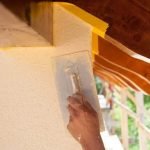How do people fund home improvements? Whether you’re looking to update your kitchen, renovate your bathroom, or add an extension to your living space, the cost of home improvements can add up quickly. In this article, we will explore the various ways in which individuals can finance their home improvement projects.
Home improvements are important for maintaining and increasing the value of your property. From enhancing curb appeal to creating a more functional and comfortable living space, investing in home improvements can have a significant impact on both the aesthetic appeal and financial value of your home.
There are several common reasons why homeowners may want to improve their homes, including addressing necessary repairs, accommodating lifestyle changes, or simply enhancing the overall look and feel of their living space. Whatever the reason may be, finding the right financing option is crucial for bringing your home improvement ideas to life.
In the following sections, we will discuss traditional financing options, using home equity for renovations, alternative funding sources, government grants and programs, as well as DIY and budget-friendly ideas for improving your home.
Common Reasons for Wanting to Improve Your Home
Many homeowners decide to pursue home improvements for a variety of reasons. Whether it’s to increase property value, enhance comfort and functionality, or simply update the look and feel of their homes, there are common motivations that drive individuals to take on these projects.
Increasing Property Value
One of the primary reasons people choose to improve their homes is to increase the property value. By investing in renovations such as kitchen or bathroom upgrades, adding a deck or patio, or enhancing curb appeal through landscaping, homeowners can potentially raise the resale value of their homes. This can be especially beneficial for those looking to sell their homes in the future or for individuals who want to build equity and wealth through property ownership.
Enhancing Comfort and Functionality
Another common reason for home improvements is to enhance comfort and functionality within the living space. This may include projects like adding additional rooms or square footage, improving energy efficiency through updated windows or insulation, or making modifications to accommodate changing needs such as aging in place. These types of improvements can greatly improve the overall quality of life for homeowners and their families.
Updating Aesthetic Appeal
Lastly, many people choose to improve their homes simply to update its aesthetic appeal. From fresh paint colors and modern fixtures to trendy design elements and architectural features, updating the look and feel of a home can make it feel more stylish and inviting. Whether it’s for personal enjoyment or attracting potential buyers, aesthetic updates can have a significant impact on how a home is perceived.
These common reasons illustrate the various motivations behind home improvements, highlighting just how important these projects can be for homeowners. Understanding these reasons can also help individuals determine what financing options may be best suited for their specific renovation goals.
Traditional Financing Options for Home Improvements
When it comes to funding home improvements, many people turn to traditional financing options for assistance. These options provide a structured and familiar way to secure funds for renovations, upgrades, and repairs. Here are some common traditional financing options for home improvements:
- Mortgage Refinance: One of the most popular ways to fund home improvements is through mortgage refinancing. This involves taking out a new mortgage loan that is larger than your existing loan, allowing you to cash out the difference and use it for renovations.
- Personal Loans: Another traditional financing option is to take out a personal loan from a bank or credit union. Personal loans typically have fixed interest rates and monthly payments, making it easier to budget for your home improvements.
- Home Equity Loan: A home equity loan allows homeowners to borrow against the equity in their property. This type of loan often has lower interest rates than other financing options because it is secured by the value of the home.
These traditional financing options provide homeowners with flexibility and stability when it comes to funding their home improvements. They offer various terms and interest rates, allowing individuals to choose the option that best fits their financial situation and renovation needs.
When considering how do people fund home improvements, it’s important to weigh the pros and cons of each traditional financing option before making a decision. Additionally, individuals should consult with financial advisors or lenders to discuss their specific needs and goals when it comes to funding their home improvement projects. With careful consideration, homeowners can find the right traditional financing option that meets their renovation needs while staying within their budget.
Using Home Equity for Renovations
Home equity refers to the value of your home minus any outstanding mortgage balance. Many homeowners use their home equity to fund renovations because it can provide access to a large sum of money at relatively low interest rates. There are several ways to tap into your home’s equity, including home equity loans and home equity lines of credit (HELOCs).
Home Equity Loan
A home equity loan is a type of loan that allows you to borrow a lump sum of money using the equity in your home as collateral. The loan terms typically range from 5 to 30 years, and the interest rate is fixed for the duration of the loan. This can be a good option if you know exactly how much money you need for your home improvements and prefer predictable monthly payments.
Home Equity Line of Credit (HELOC)
A HELOC works similarly to a credit card, allowing you to borrow funds as needed up to a certain limit over a specified period, known as the draw period. During this time, you can borrow and repay the funds multiple times. After the draw period ends, you enter the repayment period where you can no longer borrow funds and must start repaying what was borrowed.
Using home equity for renovations can be an effective way to fund your home improvements because it allows you access to a substantial amount of money at lower interest rates compared to other financing options. However, it’s important to carefully consider your financial situation and ability to repay the borrowed funds before tapping into your home’s equity.
Alternative Funding Options for Home Improvements
When it comes to financing home improvements, traditional options like personal loans or credit cards may not always be the best fit for everyone. So how do people fund home improvements if these common options are not suitable for them? Luckily, there are alternative funding options available that may better suit homeowners’ needs.
One alternative funding option for home improvements is through a home improvement loan. These loans are specifically designed for funding renovations and upgrades to your home. They often have lower interest rates compared to personal loans or credit cards, making them a more affordable option for larger projects.
Another alternative funding option is through a home improvement grant. Some local and state governments offer grants to homeowners for specific types of renovations, such as energy-efficient upgrades or accessibility improvements. These grants do not need to be repaid, making them an attractive option for those who qualify.
Finally, crowdfunding has emerged as a modern way for people to fund their home improvement projects. Platforms like GoFundMe or Kickstarter allow homeowners to create campaigns and raise money from friends, family, and even strangers who believe in their project. This can be a great way to gather community support and financial assistance for your home improvement endeavors.
| Alternative Funding Option | Description |
|---|---|
| Home Improvement Loan | Specifically designed for funding renovations and upgrades with lower interest rates. |
| Home Improvement Grant | Offered by some local and state governments for specific types of renovations that do not need to be repaid. |
| Crowdfunding | Platforms like GoFundMe or Kickstarter allow homeowners to raise money from friends, family, and the community. |
Government Grants and Programs for Home Improvements
When it comes to funding home improvements, many homeowners may not realize that there are actually government grants and programs available to help with the costs. These grants and programs are typically offered at the local, state, and federal level and can provide financial assistance or low-interest loans for specific home improvement projects. The goal of these government initiatives is to promote affordable housing, energy efficiency, and community development.
One common example of a government program for home improvements is the Federal Housing Administration (FHA) Title I Property Improvement Loan Program. This program provides loans to homeowners looking to make improvements or repairs to their homes, including everything from modernizing bathrooms to making the property more accessible for individuals with disabilities. Additionally, many local governments offer grant programs aimed at improving the energy efficiency of homes, such as upgrading insulation or installing solar panels.
| Government Program | Description |
|---|---|
| Federal Housing Administration (FHA) Title I Property Improvement Loan Program | Provides loans for various home improvement projects |
| Local Energy Efficiency Grant Programs | Offers financial assistance for energy-saving home improvements |
| Tax Incentives & Credits | Provides tax breaks for eco-friendly home upgrades |
DIY and Budget-Friendly Home Improvement Ideas
When it comes to home improvements, not everyone has the budget for major renovations or the desire to take on significant debt. Thankfully, there are plenty of do-it-yourself (DIY) and budget-friendly options that can help you spruce up your home without breaking the bank. Whether you’re looking to add value to your property or simply make it more comfortable and stylish, here are some ideas that won’t cost a fortune:
- Painting: One of the simplest and most affordable ways to give your home a fresh look is by painting the walls. You can either stick with the current color scheme or opt for something entirely new to transform the space.
- Upcycling Furniture: Instead of buying new furniture, consider giving your existing pieces a makeover. From sanding and repainting chairs to reupholstering sofas, there are numerous ways to breathe new life into your furnishings without spending a lot of money.
- Updating Fixtures: Swapping out outdated light fixtures, cabinet hardware, and faucets can make a big difference in modernizing your home. Look for sales or clearance items at home improvement stores to save even more.
Of course, DIY projects require time and effort on your part, so be sure to carefully consider what tasks you’re comfortable tackling on your own. In some cases, it may be worth hiring a professional for certain aspects of the renovation if you have any doubts about completing them successfully.
Tips for Successful DIY Home Improvements
- Research techniques and materials before starting any project
- Start with small projects if you’re new to DIY renovations
- Invest in quality tools if you plan on doing multiple renovations in the future
By incorporating budget-friendly DIY options into your home improvement plans, you can achieve a fresh and updated living space without overspending. Plus, adding personal touches through these projects can make your house feel even more like home. Remember that even though these ideas are affordable, they still require careful planning and execution for successful results.
Tips for Choosing the Right Financing Option for Your Home Improvements
When it comes to funding home improvements, there are a variety of financing options available to homeowners. With so many choices, it can be overwhelming to determine the best option for your specific needs. Here are some tips for choosing the right financing option for your home improvements.
First and foremost, it’s important to consider your current financial situation and future goals. Take a close look at your budget and assess how much you can realistically afford to spend on renovations. This will help narrow down your options and ensure that you choose a financing method that aligns with your financial capabilities.
Another important factor to consider is the scope of the home improvement project. For smaller projects, such as minor repairs or cosmetic upgrades, using personal savings or a low-interest credit card may be sufficient. However, larger scale renovations may require a more substantial investment, in which case a home equity loan or line of credit could be more appropriate.
Additionally, take into account the timeline for completing the home improvements. If you need immediate funds, traditional financing options like personal loans or home equity loans may not be feasible due to longer approval processes. In this case, alternative funding options such as peer-to-peer lending or contractor financing could provide quicker access to funds.
By carefully evaluating your financial status, understanding the scope of your project, and considering the timing of funding needs, you can make an informed decision about how to fund your home improvements in a way that meets your specific requirements and ensures success in achieving your renovation goals.
Conclusion
In conclusion, there are various ways that people can fund their home improvements depending on their financial situation and preferences. Whether it’s through traditional financing options such as personal loans or home equity loans, or alternative funding sources like credit cards or crowdfunding platforms, the key is to find the option that works best for you and your specific home improvement project.
It is important to carefully consider the pros and cons of each funding method, weighing factors such as interest rates, payment terms, and potential impact on your credit score. Additionally, exploring government grants and programs for home improvements can provide another avenue for financial support, especially for those who qualify based on specific criteria.
Ultimately, the best way to fund your home improvements will vary from person to person. Some may opt for a DIY approach and budget-friendly ideas to save money, while others may prefer to invest in professional contractors and higher-end materials.
Whatever the case may be, it is essential to thoroughly research your options and make an informed decision that aligns with your goals and financial capabilities. By doing so, you can enjoy the benefits of a more comfortable and aesthetically pleasing living space without breaking the bank.
Frequently Asked Questions
How Do People Typically Pay for Home Renovations?
People typically pay for home renovations using a combination of savings, personal loans, home equity loans, or home equity lines of credit. Some may also use credit cards or contractor financing to cover the costs.
What Is the 30 Rule for Renovations?
The 30 Rule for renovations refers to the general guideline that homeowners should spend no more than 30% of their home’s value on renovations. This rule helps prevent over-improving a property and potentially losing money if the house is sold.
What Is a Home Improvement Loan Called?
A home improvement loan is commonly called a home renovation loan or a home equity loan. These types of loans allow homeowners to borrow money specifically for improving or renovating their homes, using their home’s equity as collateral.

I’m thrilled to have you here as a part of the Remodeling Top community. This is where my journey as an architect and remodeling enthusiast intersects with your passion for transforming houses into dream homes.





